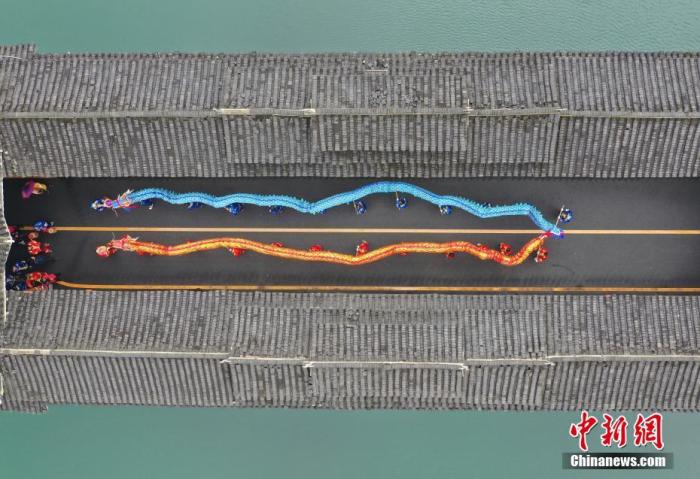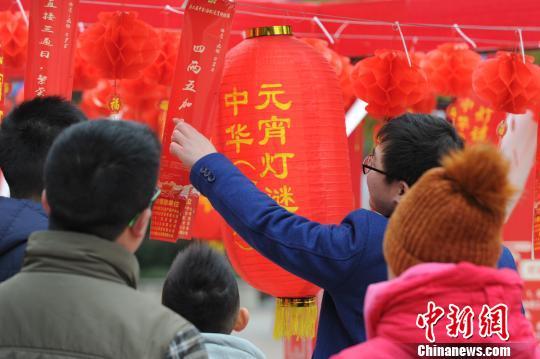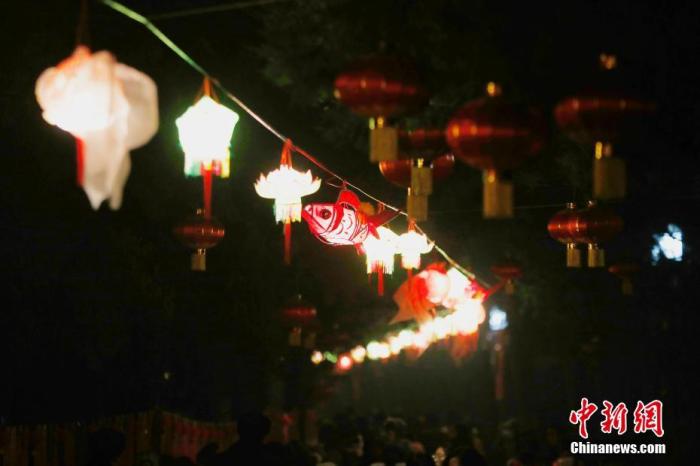This year’s Lantern Festival: the word house is waiting for relatives and friends to get together after the epidemic.
Beijing, Feb. 8 (Reporter Shangguan Yun) The 15th day of the first lunar month is the traditional Lantern Festival. On the Lantern Festival, the general folk activities include viewing lanterns, eating glutinous rice balls, solve riddles on the lanterns and so on. With the passage of time, the customs and habits of the Lantern Festival have also changed a lot.
This year’s Lantern Festival is in the period of epidemic prevention and control in COVID-19. Many netizens said that this year’s holidays should be less, no gatherings, and quiet holidays. After the epidemic, relatives and friends still get together.

Data Map: Folk artists performed dragon dances on the Fengyu Bridge in yuping county, tongren city, Guizhou Province to celebrate the Lantern Festival. China News Agency issued Hu Panxue photo
Lantern Festival is also called Shangyuan Festival. How did it come from?
Lantern Festival has a long history, and there are different opinions about its origin.
During the reign of Emperor Wu of the Han Dynasty, the activity of offering sacrifices to "Taiyi God" was scheduled for the 15th day of the first month. At that time, when the taichu calendar was founded, the Lantern Festival was identified as an important festival. "Historical Records of Le Shu" records: "Han people often spend the first month in the Xin Temple as a sweet spring, and when they are unconscious, they will die in the Ming Dynasty."
Shangyuan means the first full moon night in the new year. The origin of Shangyuan Festival is related to Taoism as recorded in Miscellanies of Years Old. It is said that Taoism has a saying that "heavenly god blesses the people, the local officials forgive sins, and the water officials relieve Eritrea".
During the Wei and Jin Dynasties, Taoism matched season and climate with the three officials mentioned above, and designated the 15th day of the first month as Shang Yuan, the 15th day of July as Zhong Yuan and the 15th day of October as Xia Yuan, which were collectively called "Three Yuan". Therefore, the fifteenth day of the first month is also called Shangyuan Festival.
In the Southern Song Dynasty, Wu Zimu said in Dream Liang Lu: "On the fifteenth day of the first month, it is the day of heavenly god blesses the people in Shangyuan."

Data map: The picture shows the staff exchanging answers with the public. Zhang Yazi photo
Solve riddles on the lanterns, Lion Dance … … Those Lantern Festival folk customs
The folk custom of Lantern Festival corresponds to New Year’s Eve, and it is also distinctive in season.
Solve riddles on the lanterns is an important folk activity of the Lantern Festival, which has been passed down from ancient times to the present. Originally, on the fifteenth day of the first lunar month, people wrote riddles on paper and pasted them on lanterns for people to guess.
Solve riddles on the lanterns has certain skill, can inspire people’s wisdom, and appeals to both refined and popular tastes, so he quickly got the response of the people and eventually became an important element of the Lantern Festival.
Playing dragon lanterns, also known as dragon dancing or dragon dancing, is also a custom of the Lantern Festival. In the Han Dynasty, Zhang Heng’s "Xijing Fu" introduced the "hundred operas", among which the dragon dance was described. According to the Records of Sui Shu Music, Huanglongbian, which is similar to the dragon dance performance in one hundred operas, is also wonderful.
"Lion Dance" began in Wei and Jin Dynasties and flourished in Tang Dynasty. It is also called "Lion Dance" and generally requires three people to cooperate with each other. Among them, two people dress up as lions, and the other one is the leader of lions. There are also civil and military dances, including shaking hair, rolling, pushing high and rolling colored balls.
Why did you want to enjoy the lanterns in the ancient Lantern Festival?
Lantern Festival custom originated earlier. It originated from the activity of expelling epidemic diseases by fire in ancient times, and the ancient form of this custom was partially preserved by the people who lit the fields on the fifteenth day of the first month and went up the mountain with torches.

Data Map: Beijing Jingshan Park held the Lantern Festival Lantern Festival, and citizens enjoyed the lanterns in Jingshan Park. China News Service reporter Futian photo
Some folklore experts once said that with the Buddhist custom of burning lanterns and offering sacrifices spreading in China, the ancient custom of burning lanterns and traveling at night at Lantern Festival gradually evolved into the custom of lighting lanterns at Lantern Festival.
The rise of nightlife in ancient cities also provided conditions for the development of the custom of decorating lanterns. The big expansion of the custom of decorating lanterns was in the Tang and Song Dynasties. In the Tang Dynasty, not only did the "Hundred Lantern Trees" be made in Beijing, but the curfew on the 14th, 15th and 16th nights of the first month was also cancelled, that is, "Jin Wu can’t help it".
During the Song Dynasty, lanterns were made with more patterns, and their skills and shapes were very ingenious, with various categories. In the Lantern Festival, according to the record of the numerous victories of the old people in the West Lake, girls in Lin ‘an in the Southern Song Dynasty "danced in the market first" to attract buyers.
In the Ming Dynasty, Tang Yin wrote a poem "Yuanxiao", which showed that Lantern Festival lanterns and the moon set each other off in an interesting way: "A moon without lights is not entertaining, and a moon without lights is not spring. In spring, people are like jade, and the lights are like silver around the moon and next month. "
The whole family gets together to eat "sweet dumplings"
Apart from watching lanterns, solve riddles on the lanterns and other customs, another deep impression people have on the Lantern Festival is probably the symbolic food "Yuanxiao".
In ancient times, Yuanxiao also had a series of titles, such as "Floating Yuanzi", and businessmen called it "Yuanbao". In ancient times, the price of "Yuanxiao" was relatively high, and a poem said: "Guests look at the Imperial Street with a hook curtain, and the treasures in the city come at one time. There is no way to go in front of the curtain, and no money can be returned. "

Data map: The picture shows the style of making glutinous rice balls into mahjong. Photo by Chen Chao
Due to regional differences, this kind of food has different names, such as Yuanxiao and Tangyuan. The north "rolls" Yuanxiao and the south "wraps" Tangyuan, and the practice and taste are slightly different. The stuffing can be vegetarian, sweet and salty. Salty stuffing generally includes diced fresh meat and dried shrimps.
In fact, the process of shaking the Lantern Festival is also a process of folk custom display, which adds a festive atmosphere to the Lantern Festival. Yuanxiao is a necessary food for festivals in many places. Family and friends eat a bowl of glutinous rice balls together, which means "reunion".
In Beijing, Jinfang Ciqikou Snack Shop has always been one of the most popular places for Lantern Festival, and the queues in previous years were long. However, according to media reports, this year, due to the need of epidemic prevention and control in COVID-19, the staff in the store have been keeping order, requiring a queue interval of more than one meter.
In addition, some time-honored brands provide convenient conditions for people to buy Yuanxiao by adding sales points, cooperating with supermarkets and entering the community.
This year’s Lantern Festival is particularly different during the epidemic prevention and control in COVID-19. Some netizens said that in any case, after the Lantern Festival this year, remember to go out less and not get together. After the epidemic is over, any day can be a day to get together. (End)